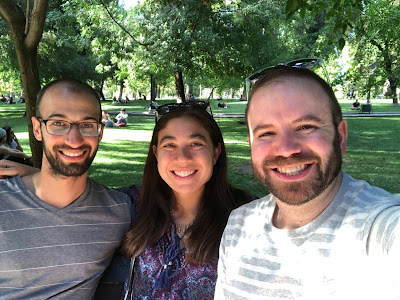Ushuaia was the departure point for our Antarctic cruise
(side note: AHHHHHHHH!!!!) and I arrived
the night before the rest of my friends did.
The city was small but heaving with tourists. There were tons of shops and restaurants the
whole way down their very long main drag, and lots of ships in the harbour,
including cruise ships of all sizes (from small expedition vessels like the one
we’d be taking, to giant cruise ships with thousands of passengers). I checked into Hotel Las Lengas – chosen by
the cruise company, G Adventures. The
room was pretty basic and lacked power outlets, but the staff were beyond
helpful and the views from the reception and lounge area were fantastic.
Because it is the capital of the region which Argentina
thinks the Falkland Islands belong to, there is a ton of stuff about the
Falklands (or “Malvinas” as they call them) in Ushuaia: various monuments to the war they started,
murals on walls, and random signs in random places (like in the parking lots at
viewpoints in the nearby national park).
It all seemed a bit desperate.
Get over it.
I had the next morning free to explore, but opted to take it
easy instead. I slept in, dropped off
laundry, did some souvenir browsing, got a haircut, and found brunch at a café
called Ana & Juana. I think I went
there five times over the course of three days (including the morning we got
back from the cruise). They had the best
alfajores I’ve had. Ever.
My friends Simon and Alyson arrived in the early afternoon
with Simon’s dad, Tony. They went for a
little hike while I waited for my friend Lenora to arrive in the early
evening. Lenora had a little fall on the
flight from the U.S. and needed a bit of medical attention. She had given me a heads up on her layover
and I sprung into action. Upon her
arrival, we went around the corner to the local hospital. I was a bit nervous with it being Argentina
and all, but the experience was really impressive for a hospital – especially
when compared to the U.S. We were in and
out in 90 minutes, and in that time she had a tooth re-inserted, was examined
by a doctor, and saw a nurse for antibiotics.
The staff were lovely and were very patient with our limited
Spanish. And it was all free. Even for tourists. Brilliant.
A+ to Argentina.
Unable to secure a rental car to head out to the ranch I
wanted to take my friends to, we opted for a museum day. The Maritime Museum of Ushuaia was much more
than just a maritime museum. Set in an
old prison, the museum included information on the anthropology of the region,
history, art, wildlife, and a section on Antarctica. There were old maps (which I LOVE) and, of
course, information on the prison itself and Ushuaia’s time as a penal
colony. It was all very reminiscent of
Australia!
After lunch, we visited the Museo del Fin del Mundo (Museum
of the End of the Earth – referring to Ushuaia’s location at the very bottom of
the planet). It was a much smaller
museum situated in an old bank building.
It had some random things including some cool stuffed birds and a
beautiful ornament of a woman which used to grace the bow of a ship. The museum also had an annex a few blocks
away at the Casa Antigua, the old legislative chamber.
After a delicious dinner of lamb meatballs, my friends and I
went down to the waterfront to get our first glimpse of our ship which had
arrived that evening. It was dwarfed by
the much larger ships around it.
As our ship was due to depart late in the afternoon, we had
booked in a half-day tour of the Tierra del Fuego National Park on our departure
day. The tour took us to two very scenic
viewpoints – Mirador Puerto Arias and Lago Roca – and offered a scenic train
ride with excellent scenery and a stop at the Macarena Waterfall. We had booked the tour through G Adventures to
ensure we got back in time to make the ship.
The tour was a bit of a rushed typical tourist bus tour and we didn’t
really get to dig into the park at all.
If I could do it over again, I’d take a smaller 4x4 tour for a full day
and avoid the typical tourist route.
After that, we got our obligatory picture in front of the
Ushuaia sign…
And then boarded the G Expedition! Next stop:
ANTARCTICA! But first, let me
take a selfie.
























